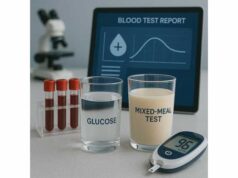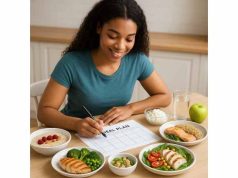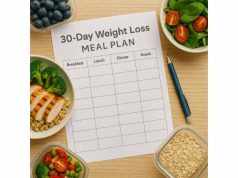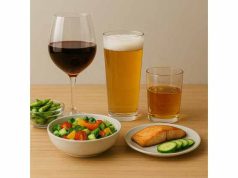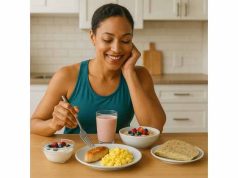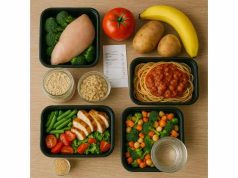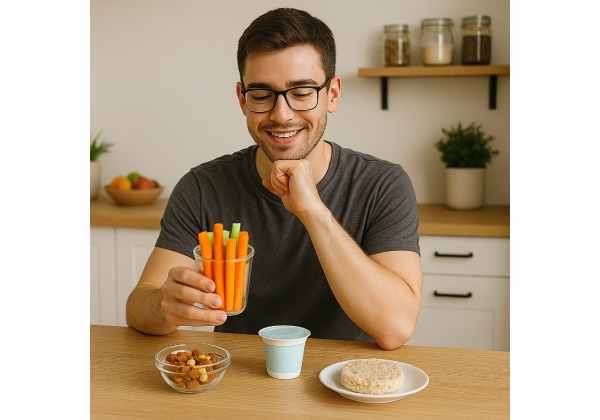
The right snack does two jobs: it takes the edge off hunger now and keeps you steady until your next meal. The wrong snack does the opposite—quick energy, faster crash, and a creeping calorie surplus. This guide shows you how to choose 100–250 calorie options that actually help a deficit, with simple formulas, ready-to-eat examples, and prepping tips. If you also want a full framework for targets and planning, see our overview of calorie goals and meal planning. Use the ideas below to build snacks that are protein-forward, fiber-rich, and satisfying—without feeling like “diet food.”
Table of Contents
- Smart snacks for weight loss
- Snack calories and macros
- 100–250 calorie ideas
- Protein-forward snack formulas
- Snack prep and shopping
- Snacking mistakes and fixes
- When to snack and when to skip
- Frequently Asked Questions
Smart snacks for weight loss
“Smart” here means snacks that blunt hunger, protect your calorie budget, and support nutrients you might miss at meals. Two principles drive this:
1) Satiety per calorie. The most filling snacks combine protein, fiber, and water. That is why Greek yogurt with berries beats crackers at the same calories. Protein slows digestion and preserves lean mass; fiber and water add stretch in the stomach and steady blood sugar.
2) Decision simplicity. You will snack better when choices are obvious and pre-decided. A written shortlist on your phone or a labeled shelf in your fridge prevents “whatever is around” from winning.
Useful rules of thumb:
- Aim for 100–250 calories per snack. Smaller (100–150) curbs minor hunger; larger (200–250) can replace a mini-meal if lunch or dinner is far away.
- Include at least 8–20 grams of protein most of the time. Higher protein works best when you are losing fat and want to hold muscle.
- Favor whole foods and minimally sweet options to prevent rebound cravings. Add fruit for sweetness; keep candy “sometimes.”
- Think “protein + produce + crunch”: a protein anchor, a fruit or veg, and a texture you enjoy (nuts, seeds, crispbread).
Context matters. Snacks exist to serve your plan, not to fill gaps randomly. If you train after work, a 200–250 calorie yogurt-and-fruit snack at 3:30 pm can keep your workout strong and prevent overeating at dinner. If evenings are your weak spot, move a snack later and pair it with tea to create a satisfying ritual.
If you are building habits from scratch, start with one change: remove a daily pastry or candy and replace it with a higher-protein option for the same or fewer calories. Then repeat next week with another swap. For broader behavior guidance and safe pacing, see our safe weight-loss basics.
Snack calories and macros
Snacks work when they fit your daily energy target and macro needs. A simple way to set guardrails:
Step 1: Budget your calories. If your daily target is 1,600–2,000 calories, you will usually have room for one to two snacks of 100–250 calories each. Not sure of your number? Estimate a personal daily calorie range, then decide how many snacks fit.
Step 2: Set protein first. During fat loss, most people do well with 1.6–2.2 g/kg of goal body weight per day. If your goal weight is 70 kg, that is 112–154 grams of protein daily. Allocate 8–20 grams of that to snacks to keep meals flexible.
Step 3: Use fiber to stretch fullness. Aiming for 25–35 grams of fiber per day helps. Snacks are a great place to add 3–8 grams through fruit, veg, pulses, or high-fiber crispbreads.
Step 4: Choose carbs and fats based on the day.
- Training days: A 150–250 calorie snack with 15–30 grams of carbs (fruit, yogurt, whole grains) can improve energy for workouts.
- Desk-heavy days: A lower-carb, higher-protein snack (jerky with veg, cottage cheese) may sustain focus without post-snack sleepiness.
What this looks like in practice
- 100–150 calories: quick hunger check. Examples: 170 g (6 oz) plain skyr (100–120 cals, ~16–18 g protein); one medium apple with 1 tsp peanut butter (~140 cals); 20–25 g roasted edamame (~120 cals, ~12 g protein).
- 150–200 calories: more staying power. Examples: ¾ cup low-fat cottage cheese with cucumber and salt (~160 cals, ~20 g protein); 1 whole-grain crispbread with 60 g tuna (~180 cals, ~16 g protein).
- 200–250 calories: mini-meal. Examples: 170 g Greek yogurt with ½ cup berries and 10 g chopped walnuts (~220 cals, ~18 g protein); 2 hard-boiled eggs plus baby carrots (~220 cals, ~12 g protein).
Macro patterns that help adherence
- Protein anchor: dairy, eggs, tofu, edamame, lean meats, protein shakes, lentils.
- Volume foods: berries, apples, carrots, cucumbers, cherry tomatoes, air-popped popcorn.
- Flavor boosters (measured): nuts, seeds, hummus, pesto, dark chocolate, olive oil—small amounts add satisfaction without blowing the budget.
Finally, remember that consistency beats precision. Your snack can be 180 calories some days and 220 on others. The weekly pattern matters more than a perfect daily number.
100–250 calorie ideas
Below are mix-and-match options organized by cravings and situations. Portions are typical supermarket sizes; adjust to your numbers and appetite.
Quick high-protein (grab-and-go)
- Skyr or Greek yogurt, plain (170 g / 6 oz): 100–130 calories, 16–18 g protein. Add cinnamon, vanilla, or a few frozen berries.
- Low-fat cottage cheese (¾ cup / ~170 g): ~160 calories, ~20 g protein. Top with cucumber and black pepper.
- Roasted edamame or soy crisps (20–30 g): 90–140 calories, 10–15 g protein.
- Turkey or chicken breast slices (60–80 g) + mustard: 120–150 calories, ~15–20 g protein.
- Tuna pouch (70–85 g) + whole-grain crispbread: 170–220 calories, 14–20 g protein.
- Protein shake (1 scoop whey in water): 110–140 calories, 20–25 g protein. If you prefer whole foods, pair half a portion with fruit.
Sweet tooth without the crash
- Greek yogurt “parfait”: 170 g plain yogurt + ½ cup strawberries + 1 tsp honey or non-nutritive sweetener: 150–190 calories.
- Chocolate and fruit: 15 g dark chocolate (1–2 squares) + an orange: 150–180 calories.
- Chia pudding (mini): 1 tbsp chia + ½ cup milk + vanilla; set overnight: ~120–150 calories.
- Baked apple slices with cinnamon: 1 medium apple air-fried or baked, dusted with cinnamon: ~95–120 calories; add 1 tbsp crushed walnuts for a 200–220 calorie option.
Savory and crunchy
- Hummus plate: 3 tbsp hummus + raw veg (carrots, cucumber, peppers): 150–200 calories.
- Eggs and veg: 2 hard-boiled eggs + cherry tomatoes: 200–220 calories.
- Mini tuna-avocado boats: 60 g tuna + 30 g mashed avocado in cucumber boats: 180–220 calories.
- Cheese and fruit: 30 g part-skim mozzarella + pear: 180–210 calories.
Desk-friendly and commute-proof
- Apple + 20 almonds (weighed): ~220–250 calories; reduce to 12 almonds (~180 calories) for a lighter option.
- Air-popped popcorn (3 cups) + nutritional yeast: 100–120 calories; add 1 tsp olive oil spray to boost flavor at ~40 calories.
- Jerky (30 g) + baby carrots: 140–180 calories, 10–15 g protein.
- Whole-grain crispbread + light cheese spread (2 tsp): 120–160 calories.
Plant-based protein
- Edamame (shelled, ¾ cup): 150–180 calories, 14–18 g protein.
- Lentil salad cup: ½ cup cooked lentils + lemon + herbs: 160–200 calories.
- Tofu cubes (120 g) pan-seared in 1 tsp oil + soy sauce: 200–230 calories, ~16–20 g protein.
- Peanut butter banana bites: ½ small banana + 1 tbsp peanut butter: 150–170 calories.
Pre-workout and recovery
- Yogurt + banana (½ small): 180–220 calories; quick carbs and protein.
- Rice cakes (2) + 1 tbsp peanut butter: 190–220 calories.
- Cottage cheese + pineapple (½ cup): 180–210 calories.
Late-night calmers
- Warm milk (240 ml / 1 cup) + cinnamon: 100–130 calories; pair with 1–2 whole-grain crackers for ~150–180.
- Blueberries (1 cup) + 10 g walnuts: 120–150 calories.
- Chamomile tea + 15 g dark chocolate: 100–120 calories.
Want more protein ideas to rotate through the week? Browse our concise high-protein foods list for portable options and serving sizes.
Protein-forward snack formulas
You do not need countless recipes; a few repeatable “formulas” cover most situations. Think in components and you will build satisfying snacks from whatever is in your kitchen or convenience store.
Formula A: Dairy base + fruit + crunch (180–240 calories)
- Base: Greek yogurt or skyr (170 g).
- Fruit: ½–1 cup berries, diced apple, or orange segments.
- Crunch: 10 g chopped nuts or 1 tbsp high-fiber granola.
- Why it works: ~18 g protein plus fiber and water for fullness, with just enough fat for satisfaction.
Formula B: Lean protein + veg + dip (150–220 calories)
- Protein: 2 eggs; 60–80 g turkey; ½ cup cottage cheese; ½ cup edamame.
- Veg: carrots, cucumbers, tomatoes, peppers—at least a fistful.
- Dip/Flavor: 2–3 tbsp hummus, salsa, mustard, or yogurt-herb dip.
- Why it works: Protein steadying effect plus volume from veg.
Formula C: Whole-grain + spread + topper (160–230 calories)
- Grain: 1–2 crispbreads or rice cakes; 1 small slice whole-grain toast.
- Spread: 1 tbsp nut butter or light cheese.
- Topper: sliced strawberries, cucumber, or everything bagel seasoning.
- Why it works: Crunch and chew slow eating; measured fats keep calories in check.
Formula D: Plant protein bowl (190–250 calories)
- Base: ½ cup lentils or beans.
- Add: chopped tomatoes, scallions, lemon, herbs; optional 1 tsp olive oil.
- Why it works: Fiber + protein combination creates long-lasting fullness.
If you are dialing protein for fat loss, align snack protein with your daily protein targets and let meals provide the rest.
Snack prep and shopping
Preparation turns good intentions into automatic wins. A one-hour weekend session can stock a week of smart snacks.
Set up your environment
- Clear a “snack shelf.” Put ready options at eye level in the fridge and pantry.
- Pre-portion once. Use 8–10 small containers or zipper bags for nuts, edamame, popcorn, and chopped veg.
- Label by calories. A small sticker (“150” or “220”) reduces mental math during busy days.
Ten-minute prep ideas (per 3–5 servings)
- Veg box: Slice carrots, cucumbers, peppers; portion with 3 tbsp hummus cups.
- Yogurt kits: 170 g plain Greek yogurt + frozen berry packets (½ cup each) + 10 g nuts in tiny bags.
- Eggs: Hard-boil 8–12; store peeled for fast access.
- Lentil cups: Cook a pot of lentils; portion ½ cup with lemon and herbs.
Smart shopping list
- Dairy: Greek yogurt, skyr, cottage cheese, light cheese sticks.
- Proteins: tuna pouches, turkey slices, eggs, edamame, roasted chickpeas, jerky.
- Produce: berries, apples, oranges, carrots, cucumbers, cherry tomatoes.
- Crunch: whole-grain crispbreads, rice cakes, air-pop kernels.
- Flavor: hummus, salsa, mustard, herbs, cinnamon, vanilla, everything seasoning.
- Indulgence in control: 70–85% dark chocolate, measured nut butter.
Make it routine
- Prep Sunday, top-up Wednesday.
- Place a “work snack kit” in your bag or desk: nuts (weighed), jerky, tuna, crispbreads, tea bags.
- Keep a water bottle near snacks to slow eating and add fullness.
Want a simple weekend blueprint? Follow our one-hour meal prep to batch a week of grab-and-go options.
Snacking mistakes and fixes
Mistake 1: Grazing instead of snacking.
Small bites every hour can quietly add 400–600 calories.
Fix: Set a snack window (for example, 10:30–11:30 am and 3:00–4:00 pm). Outside those windows, drink water or tea and wait 20 minutes before deciding to eat.
Mistake 2: All carbs, little protein.
Crackers, pretzels, and sweets digest fast and trigger rebound hunger.
Fix: Anchor with 8–20 grams of protein. Add fruit or veg for bulk, then layer a small amount of fat for staying power.
Mistake 3: “Health halo” portions.
Nuts, granola, and peanut butter are nutritious—and easy to overpour.
Fix: Weigh once. Learn that 12 almonds ≈ 80 calories; 1 tbsp peanut butter ≈ 90–100. Use teaspoons or pre-portioned packs.
Mistake 4: Drinking calories you forget.
Coffee drinks, juices, and “healthy” smoothies can top 300–500 calories.
Fix: Choose unsweetened tea, black coffee, or a small latte with cinnamon; if you add sweetness, keep it measured.
Mistake 5: Snacking because the clock says so.
Eating when not hungry trains you to expect food at fixed times.
Fix: Use a hunger scale (0–10). Snack around 3–6; skip at 1–2; if you hit 7–8 before dinner, choose a 200–250 calorie option with protein.
Mistake 6: Plate blind spots.
Building snacks on a plate or bowl controls portions and adds mindfulness.
Fix: Apply the plate method in mini: half produce, a palm of protein, a thumb of fats, small starch if needed.
When to snack and when to skip
Not every day needs snacks. Use them strategically based on hunger, schedule, and training.
Snack when…
- Meals are 4–6 hours apart and hunger rises to a distracting level.
- You train within 1–2 hours and want steady energy.
- You are shifting to a lower-calorie plan and need a bridge snack to avoid overeating at the next meal.
- You are building protein distribution across the day to support muscle while losing fat.
Consider skipping when…
- Meals are spaced 3–4 hours and you are not hungry.
- You are consistently overshooting calories because snacks “open the door” to extra eating.
- You are experimenting with time-restricted eating and feel fine without a snack.
- You notice that sweet snacks increase cravings; use a higher-protein mini-meal at the next planned mealtime instead.
A simple decision tool
- Rate hunger (0–10).
- If ≤2, drink water or tea and wait 15 minutes.
- If 3–6, choose a 100–200 calorie protein-forward snack.
- If ≥7 and the next meal is far away, choose a 200–250 calorie snack with protein + fiber.
Track your 14-day weight trend and energy. If snacks help you adhere and workouts feel better, keep them. If the trend stalls, remove the lowest-value snack or swap it for a lighter option.
Frequently Asked Questions
How many snacks should I have a day for weight loss?
Most people do well with one to two snacks of 100–250 calories, depending on meal timing and hunger. If meals are close together, you may not need snacks. Let your daily calorie target and appetite guide you rather than a fixed rule.
What is a good protein target for a snack?
Aim for 8–20 grams of protein per snack. Lower amounts (8–12 g) suit small hunger dips; higher amounts (15–20 g) work when lunch or dinner is several hours away, or after training. Pair protein with fruit or vegetables to add volume and fiber.
Are 100 calorie snack packs useful?
They can help portion control, but many are refined carbs that do not satisfy. If you use them, add protein—yogurt, jerky, or cottage cheese—to prevent rebound hunger. In general, choose snacks with protein, fiber, and water for better satiety per calorie.
What should I eat before a workout if I am cutting calories?
About 60–120 minutes before training, choose 150–250 calories with 15–30 grams of carbs and 10–20 grams of protein—such as Greek yogurt with half a banana or rice cakes with peanut butter. This supports performance without overshooting your budget.
Are night snacks okay for weight loss?
Yes, if you are hungry and stay within your daily calories. Choose calming, protein-leaning options—cottage cheese with fruit, warm milk with cinnamon, or yogurt with berries. If nighttime snacking leads to overeating, shift calories earlier and build more filling meals.
What if I am always hungry between meals?
First, check meals: include 25–40 grams of protein, high-fiber carbs, and vegetables. Then add a planned 150–200 calorie snack between long meal gaps. Hydrate, slow down eating, and use foods with texture and chew to extend fullness.
References
- Systematic Review and Meta-Analysis on the Effect of Portion Size and Ingestive Frequency on Energy Intake and Body Weight among Adults in Randomized Controlled Feeding Trials 2021 (Systematic Review & Meta-analysis)
- Systematic review and meta‐analysis of protein intake to support muscle mass and function in healthy adults 2022 (Systematic Review & Meta-analysis)
- Effects of 6 Months of Soy-Enriched High Protein Compared to Eucaloric Low Protein Snack Replacement on Appetite, Dietary Intake, and Body Composition in Normal-Weight Obese Women: A Randomized Controlled Trial 2021 (RCT)
- Athletes’ nutritional demands: a narrative review of nutritional requirements 2024 (Narrative Review)
Disclaimer
This article shares general nutrition guidance and practical examples for weight management. It is not a substitute for medical advice, diagnosis, or treatment. Talk with your healthcare provider about your health history, medications, and personal goals before making significant dietary changes.
Share and follow
If these ideas helped, please share the article with someone planning their week. For steady, research-based tips, follow us on the social network you use most.

